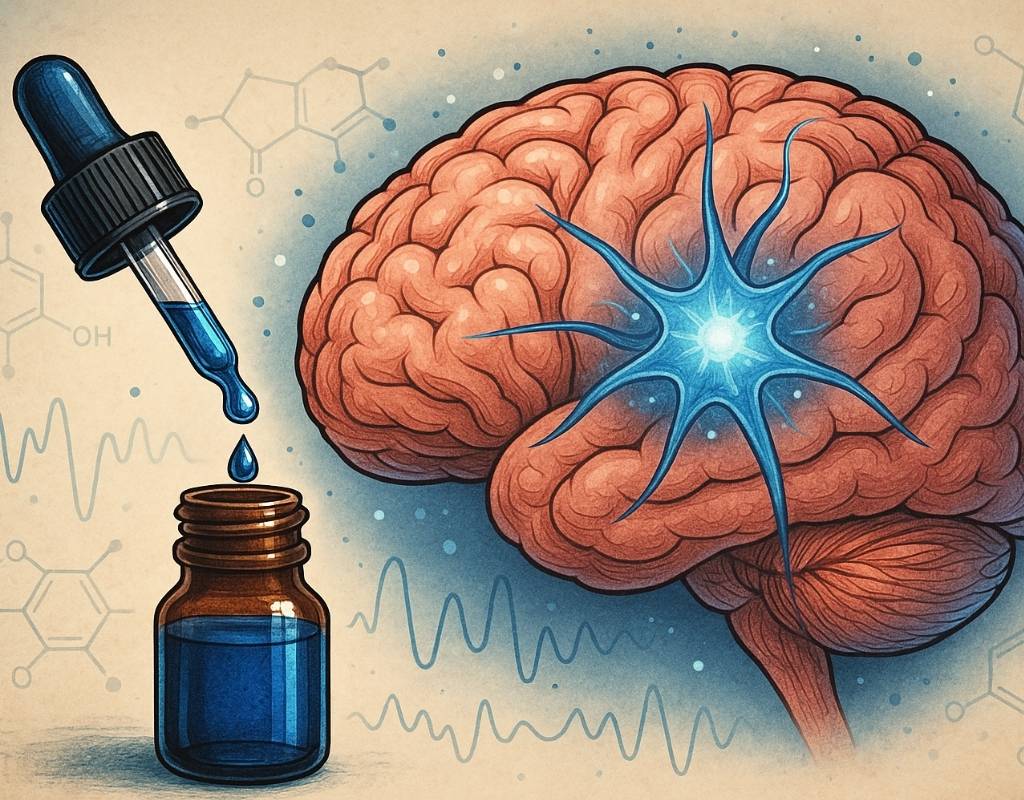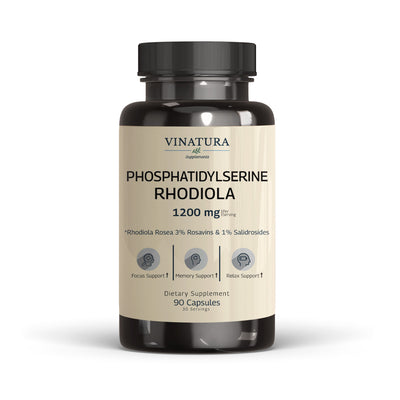
Is Methylene Blue Supplement Really a Brain Booster?
Originally developed in the 19th century as a textile dye, Methylene Blue (MB) has had a remarkable journey to become the first synthetic compound used in medicine. In recent years, MB has gained attention as a potential dietary supplement for brain health.
Early studies suggest it may improve memory, enhance brain blood flow, and support mitochondria, the "powerhouses" of cells. However, not all MB is the same. This article explores MB’s potential, mechanisms, and key considerations to help you make informed decisions about its use for brain health.
Before exploring further, please read the disclaimer located at the end of this webpage.
Key Takeaways
- Some studies suggest low doses may improve memory and focus in healthy individuals.
- It supports mitochondrial function and brain blood flow, but human clinical evidence is limited.
- Side effects may include blue-green urine, nausea, and headaches.
- Pregnant women, those with G6PD deficiency, or individuals on psychiatric medications should avoid Methylene Blue.
What Is Methylene Blue?

Methylene Blue (MB) is a unique chemical compound that was first synthesized in 1876 by German chemist Heinrich Caro. Originally, it was developed as a dye for the textile industry [10].
However, a major turning point came in 1891 when scientist Paul Ehrlich pioneered the use of MB for medical purposes. This marked one of the earliest milestones in the history of modern chemotherapy [25].
Since then, MB has been explored in a wide range of biomedical fields. It has been used for staining tissues under the microscope, as a disinfectant [20].
MB works by participating in electron transfer processes, helping to restore hemoglobin to its active state and improve the blood’s ability to transport oxygen [21].
Pharmaceutical-grade Methylene Blue is currently approved by both the FDA and EMA for medical use. This grade meets strict purity standards, undergoes tight impurity controls, and is typically available in sterile injection form [26].
Meanwhile, MB has also entered the dietary supplement market, opening new possibilities for supporting mitochondrial function and cognitive performance. However, it's important to note that supplement-grade MB can vary in purity, stability, and formulation quality depending on the manufacturer.
That’s why it’s essential to choose products from trusted brands that provide third-party testing, clear labeling, and transparency about concentration and dosage. Understanding the differences between grades—and making informed decisions—can help users safely harness the potential benefits of MB as a supplement.
How Might Methylene Blue Support Brain Health?
Methylene Blue (MB) is gaining attention for its potential to support brain health through various biological mechanisms. While most evidence comes from in vitro or animal studies, these findings offer promising insights into its possible use for improving cognitive function.
One key mechanism is its ability to support mitochondrial function. MB acts as an electron carrier, helping maintain the electron transport chain, especially when mitochondria are damaged [19].
At low concentrations, MB boosts ATP production, increases oxygen consumption, and restores mitochondrial membrane potential, all critical for the survival and efficiency of brain cells [30].
Dr. Paul Anderson notes, “Methylene Blue may support nerve function and improve memory by enhancing mitochondrial activity”. However, these findings need confirmation through human clinical trials.

Additionally, MB is recognized for its strong antioxidant properties. It neutralizes free radicals, reducing oxidative stress, a major cause of neuronal damage. Specifically, MB redirects electron flow in mitochondria to suppress superoxide production [19].
It also activates antioxidant genes like Nrf2/ARE and catalase, strengthening the body’s natural cellular defenses [21]. While these effects have been observed in models of skin aging and kidney toxicity [29], their application to human brain health requires further study.
MB also enhances energy supply to brain cells. The brain is the body’s most energy-demanding organ, and MB supports oxidative metabolism by stimulating cytochrome oxidase activity [19]. This improves memory and cognitive function while reducing neuronal death [28].
Dr. Anderson notes that MB may help support energy metabolism in brain regions involved in memory.
Finally, MB shows potential in improving brain blood flow, essential for cognitive function and alertness. Studies indicate MB increases cerebral blood flow and oxygen consumption, particularly under low-oxygen conditions [11].
It also helps maintain the integrity of the blood-brain barrier, limiting damage from ischemia and supporting nitric oxide regulation, which is associated with blood flow and vessel dilation [15, 6].
However, like other mechanisms, most data come from animal models, and more human clinical research is needed to confirm effectiveness.

What Does the Research Say?
Research on Methylene Blue (MB) and its potential to support brain health is gaining interest, but evidence remains preliminary. The table below summarizes key studies, highlighting findings and limitations.
|
Study (Author, Year) |
Sample / Method |
Key Findings |
Study Type |
Notes |
|
Wischik et al., 2015 [27] |
321 patients with mild to moderate Alzheimer’s, given MB (138 mg/day) or placebo for 24 weeks, assessed brain blood flow via SPECT. |
138 mg MB reduced cognitive decline and improved brain blood flow, with benefits sustained after 12 months. |
Randomized controlled trial (Phase 2) |
Higher doses (228 mg) were less effective, indicating dose-dependent response. |
|
Rodriguez et al., 2016 [23] |
26 healthy adults (22–62 years), given low-dose MB (4 mg/kg) or placebo, assessed via fMRI. |
Low-dose MB was associated with improvements in attention, short-term memory, and brain blood vessel response |
Randomized, double-blind trial |
Low doses effective, but high doses (>10 mg/kg) may cause adverse effects. |
|
Alda et al., 2017 [2] |
37 adults with bipolar disorder, given low-dose (15 mg/day) or high-dose (195 mg/day) MB for 12 weeks. |
A clinical trial in bipolar patients found reduced symptoms of anxiety and depression with MB, but this was under physician supervision and not applicable to dietary supplement use. |
Randomized crossover trial |
High doses caused side effects like nausea and headaches. |
|
Poteet et al., 2012 [22] |
HT-22 cells and mouse models. |
MB reduced free radicals, enhanced mitochondrial activity, and protected neurons. |
In vitro and animal study |
Results need human confirmation. |
|
Lin et al., 2012 [13] |
HT-22 cells, isolated mitochondria, and mice, assessed via MRI. |
MB increased brain blood flow, oxygen use, and glucose uptake in hippocampus and cortex. |
In vitro and animal study |
Animal-based; needs clinical trials. |
Overall, while Methylene Blue shows early promise in laboratory and clinical research, its role in supporting brain health remains unproven. More rigorous human studies are needed before any definitive conclusions can be drawn. The table below summarizes selected studies, highlighting both findings and limitations.
These studies range from preclinical experiments to early-stage human trials. While some findings suggest possible benefits related to brain function, such as cellular protection or blood flow, these results have not been verified in large-scale clinical trials.
MB is not FDA-approved for any cognitive, circulatory, or psychiatric indication. Consumers should be cautious when considering MB as a supplement due to its variable purity, limited human data, and potential side effects at higher doses. Ongoing research will help clarify its true potential.
Is It Safe to Use Methylene Blue as a Supplement?
Methylene Blue (MB) is recognized for its potential to support brain health, but its use as a dietary supplement warrants caution. One concern is product quality—low-grade supplements may lack strict purity standards, raising the risk of contamination or inconsistent dosing [23].
Additionally, at high doses, MB may disrupt redox balance and contribute to the formation of harmful free radicals [31].
Beyond these concerns, MB may also cause several side effects, including:
- Blue-green urine, saliva, or bile, typically resolving within days [21].
- Digestive issues like nausea, vomiting, diarrhea, or stomach pain, which may lessen with food or taste-masked forms [17].
- Mild, temporary urinary symptoms like difficulty urinating or frequent urination [17].
- Headaches, dizziness, or feelings of weakness [26].
- Hemolytic anemia in individuals with G6PD deficiency, especially children [5].
MB also interacts with medications. As an MAO-A inhibitor, it carries a risk of serotonin syndrome when combined with serotonin-affecting drugs like SSRIs (e.g., citalopram, duloxetine) [10].
The FDA cautions against using MB with SSRIs, especially at high doses or when administered intravenously [21]. While the risk is lower with oral forms, it still warrants caution [26].
Always consult a healthcare professional before using MB as a supplement to ensure safety and minimize potential risks.
Who Might Benefit from Methylene Blue — and Who Should Avoid It?
While Methylene Blue (MB) shows promising potential as mentioned above, it’s important not to rush into adding it to your daily routine. MB is not a miracle cure, and it’s certainly not suitable for everyone.
The table below outlines who may consider using MB—and who should avoid it.
|
Potentially Beneficial |
Not Recommended For |
|
People with high cognitive demands: Individuals performing mentally intensive tasks, like programmers or researchers, may be interested in MB due to studies suggesting improved short-term memory and attention [23]. However, broad efficacy is unproven. |
Pregnant or breastfeeding women: Insufficient safety data exist for MB during pregnancy or breastfeeding, so it should be avoided to protect maternal and infant health [21]. |
|
Older adults: Those seeking to support cognitive function may find MB appealing, as studies suggest it may reduce cognitive decline [27]. Further research is needed. |
People using serotonin-affecting drugs (SSRIs): MB risks serotonin syndrome when combined with drugs like citalopram or duloxetine, making it contraindicated [10]. |
|
Those seeking better brain blood flow: Individuals interested in improving cerebral circulation may consider MB, as animal studies show it enhances blood flow and oxygen metabolism [13]. Expert guidance is necessary. |
Individuals with G6PD deficiency: MB can cause hemolytic anemia, particularly in children, and should be avoided [5]. |
|
People with psychiatric conditions using MAOIs: As an MAO-A inhibitor, MB may cause dangerous interactions with psychiatric medications, increasing complication risks [21]. |
Methylene Blue vs. Other Brain-Boosting Ingredients
Methylene Blue (MB), alongside compounds like Ginkgo Biloba, Citicoline, and Alpha-GPC, is being studied for its potential to enhance brain function. Each has distinct mechanisms, popularity, and research support.
The table below compares these factors to help readers understand differences and choose wisely.
|
Ingredient |
Mechanism of Action |
Popularity/Application |
Research Support |
|
Methylene Blue |
Preclinical studies suggest that Methylene Blue may interact with tau and amyloid-beta proteins—markers associated with cognitive decline—but these findings have not been validated in human supplement use and do not indicate treatment effects. MB is not FDA-approved for Alzheimer’s disease or any neurological condition. |
Long medical history, used for methemoglobinemia, septic shock, and imaging. Being explored as a cognitive supplement [16,23]. |
Strong preclinical research (improved memory, neuroprotection). Limited human trials, mainly low doses for attention and short-term memory [1, 3,10,13]. |
|
Ginkgo Biloba |
Increases acetylcholine and dopamine, reduces inflammation and oxidative stress, and enhances brain oxygen metabolism [18]. |
Popular herbal supplement, considered safe for memory and cognitive support related to aging [8]. |
Multiple studies show improved cognitive and psychiatric symptoms in dementia and mild cognitive impairment [9]. |
|
Citicoline |
Boosts choline supply, supports acetylcholine synthesis, and protects neuronal membranes from ischemic damage [4]. |
Widely used, stroke, and age-related memory loss, well-tolerated [4]. |
Improves attention and alpha EEG waves in healthy adults; robust clinical research, safe [4]. |
|
Alpha-GPC |
Increases choline and acetylcholine, promotes hippocampal neurogenesis, and protects neurons [12]. |
Common cognitive supplement, enhances motivation [12]. |
Meta-analyses show improved cognitive function (MMSE), neuroprotection, and efficacy in healthy adults [24]. |
Overall, ingredients like Ginkgo Biloba, Citicoline, and Alpha-GPC have been extensively studied and are widely used to support memory and cognitive function [4, 9].
Meanwhile, Methylene Blue (MB) is an emerging compound with its own unique potential. Most importantly, you should consider your personal health condition and goals when choosing the most suitable supplement.
Conclusion
So, should you use Methylene Blue?
The answer depends on your personal goals. Methylene Blue is a compound that’s gaining attention, but current evidence is still insufficient to recommend it for widespread use. Considering it as a low-dose supplement may be an option—but only under the guidance of a healthcare professional.
Most importantly, remember that no supplement is a miracle cure. Your brain cannot function at its best if your body is constantly fatigued or under stress. Proper rest and recovery remain the foundation of lasting mental performance and overall well-being.
Testimonial Disclaimer
*The testimonials presented on this website are provided by individuals based on their personal experiences with our products. These testimonials represent individual opinions and experiences, which may not be typical or applicable to all users of our products. Results may vary depending on a variety of factors, including individual health, lifestyle, and adherence to product usage instructions.References
- [1] Abdel-Salam, O., et al. (2016). Methylene Blue Protects against Toluene-Induced Brain Damage. Reactive Oxygen Species. https://doi.org/10.20455/ros.2016.855
- [2] Alda, M., et al. (2017). Methylene blue treatment for residual symptoms of bipolar disorder. British Journal of Psychiatry. https://doi.org/10.1192/bjp.bp.115.173930
- [3] Biju, K. C., et al. (2018). Methylene Blue Ameliorates Olfactory Dysfunction. Neuroscience. https://doi.org/10.1016/j.neuroscience.2018.04.008
- [4] Bruce, S. E. (2011). EEG improvements from citicoline beverage. Int J Food Sci Nutr. https://doi.org/10.3109/09637486.2011.632623
- [5] Calderón, M., et al. (2017). Methylene blue for treating malaria. Cochrane Database. https://doi.org/10.1002/14651858.cd012837
- [6] Fernando, S. M., et al. (2024). Methylene Blue in Septic Shock. Crit Care Explor. https://doi.org/10.1097/cce.0000000000001110
- [7] Galvan, J., et al. (2021). Methylene Blue for Health Conditions. Braz Arch Biol Technol. https://doi.org/10.1590/1678-4324-20212002660266
- [8] Grieb, P. (2015). Citicoline and Memory. Med Sci Rev. https://doi.org/10.12659/msrev.894711
- [9] Guilherme, M. L., et al. (2024). Ginkgo biloba and Alzheimer’s. Antioxidants. https://doi.org/10.3390/antiox13060651
- [10] Howland, R. H. (2016). Methylene Blue: From Stain to Brain. J Psychosoc Nurs Ment Health Serv. https://doi.org/10.3928/02793695-20160920-04
- [11] Huang, S., et al. (2013). Methylene blue boosts fMRI and oxygen use. NeuroImage. https://doi.org/10.1016/j.neuroimage.2013.01.027
- [12] Li, J., et al. (2025). L‐Alpha‐GPC Review. J Food Sci. https://doi.org/10.1111/1750-3841.70338
- [13] Lin, A.-L., et al. (2012). Methylene Blue Enhancer. PLoS ONE. https://doi.org/10.1371/journal.pone.0046585
- [14] Lu, G., et al. (2018). Methylene blue for malaria: Review. BMC Med. https://doi.org/10.1186/s12916-018-1045-3
- [15] Miclescu, A., et al. (2010). Methylene blue protects BBB. Crit Care Med. https://doi.org/10.1097/ccm.0b013e3181f26b0c
- [16] Monis, A., & Maple, K. (2024). Methylene Blue Overview. https://medicalantiaging.com/.../MAA-Methylene-Blue.docx.pdf
- [17] Mullaicharam, B. (2013). Ginkgo biloba in Brain Health. https://www.researchgate.net/.../260640697...
- [18] Müller, O., et al. (2019). Is Methylene Blue Worthwhile? Exp Rev Anti Infect Ther. https://doi.org/10.1080/14787210.2019.1634545
- [19] Narriman L. C., et al. (2003). Methylene blue in rats. Pharmacol Biochem Behav. https://doi.org/10.1016/j.pbb.2003.10.007
- [20] Oz, M., et al. (2010). Methylene Blue in CNS. Med Res Rev. https://doi.org/10.1002/med.20177
- [21] Oz, M., et al. (2009). Methylene blue and Alzheimer’s. Biochem Pharmacol. https://doi.org/10.1016/j.bcp.2009.04.034
- [22] Poteet, E., et al. (2012). Methylene Blue Derivatives. PLoS ONE. https://doi.org/10.1371/journal.pone.0048279
- [23] Rodriguez, P., et al. (2016). fMRI of Methylene Blue. Radiology. https://doi.org/10.1148/radiol.2016152893
- [24] Sagaro, G. G., et al. (2023). Choline Alphoscerate Review. J Alzheimer’s Dis. https://doi.org/10.3233/jad-221189
- [25] Schirmer, R. H., et al. (2003). Methylene Blue as Antimalarial. Redox Rep. https://doi.org/10.1179/135100003225002899
- [26] Simon, S. R. (2024). Oropharyngeal Dysphagia Diagnosis. https://doi.org/10.26481/dis.20240328ss
- [27] Wischik, C. M., et al. (2015). Tau Aggregation Therapy. J Alzheimer’s Dis. https://doi.org/10.3233/jad-142874
- [28] Wrubel, K. M., et al. (2007). Methylene Blue and Learning. Pharmacol Biochem Behav. https://doi.org/10.1016/j.pbb.2007.02.018
- [29] Xiong, Z.-M., et al. (2017). Anti-Aging Methylene Blue. Sci Rep. https://doi.org/10.1038/s41598-017-02419-3
- [30] Xue, H., et al. (2021). Methylene Blue as Anti-Aging Drug. Cells. https://doi.org/10.3390/cells10123379
- [31] Rojas, J. C., et al. (2012). Memory Enhancement with Methylene Blue. Prog Neurobiol. https://doi.org/10.1016/j.pneurobio.2011.10.007
Author

Product Disclaimer
Including an ingredient or study does not evaluate, endorse, or recommend any Vinatura product or any third-party product. Some ingredients discussed may not be used in any Vinatura product.
The content of the articles has not been evaluated by the Food and Drug Administration (FDA) and is not intended to promote or endorse any specific product. Any products sold on this website are not intended to diagnose, treat, cure, or prevent any disease.
Opinions and Endorsements
Any claims, statements, or opinions expressed in the articles are those of the author(s) and do not necessarily reflect the views or opinions of the manufacturers of the dietary supplement products. The products sold on this website are separate from the content of the articles and are not directly endorsed or associated with the information presented here.
Liability Disclaimer
The author(s) of the articles, website, and manufacturers of the dietary supplement products do not assume any liability for any potential consequences arising from the use of the information provided in the articles. Ingredient effects, dosages, and safety vary by individual, formulation, and context; some ingredients interact with medications or may be unsuitable during pregnancy or lactation. It is recommended that individuals consult with a qualified healthcare professional before making any dietary or lifestyle changes, including the use of dietary supplements.
Product Usage
Please refer to the product labels and packaging for specific usage instructions and guidelines for the dietary supplement products sold on this website.
Customer Support
For any concerns or questions regarding the dietary supplement products, please contact our customer support team, who will be more than happy to assist you.





Leave a Comment
Be the first to comment.
What do you think?